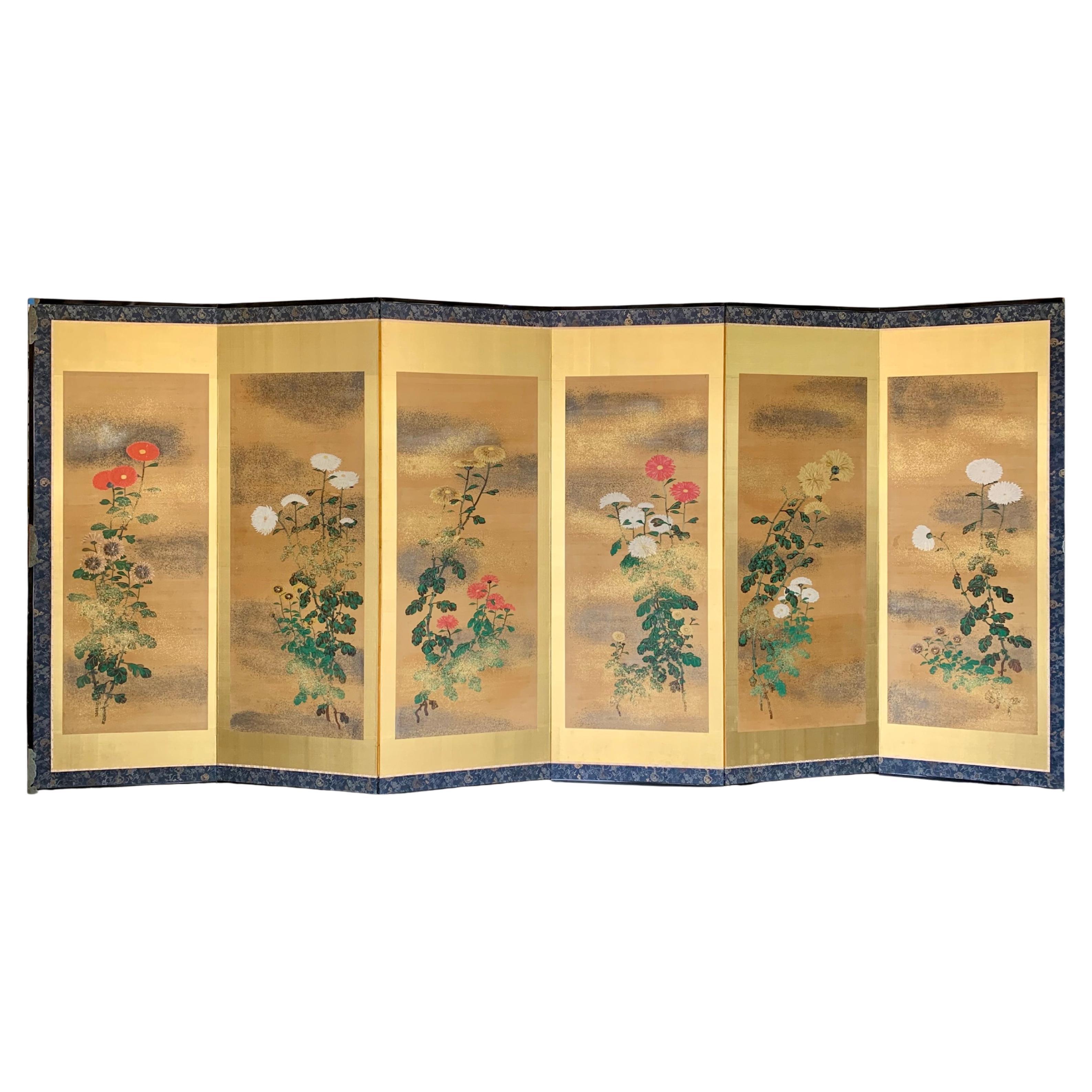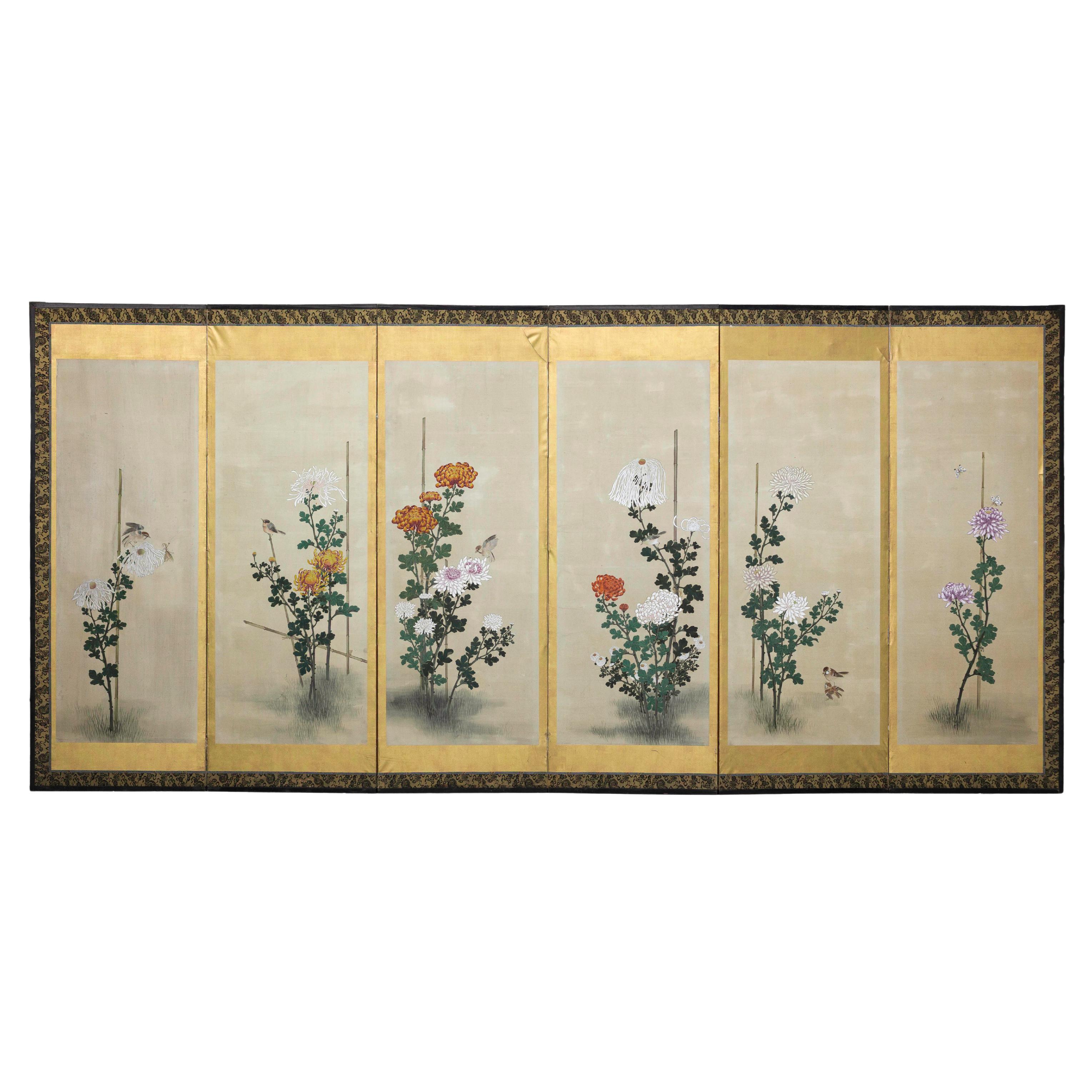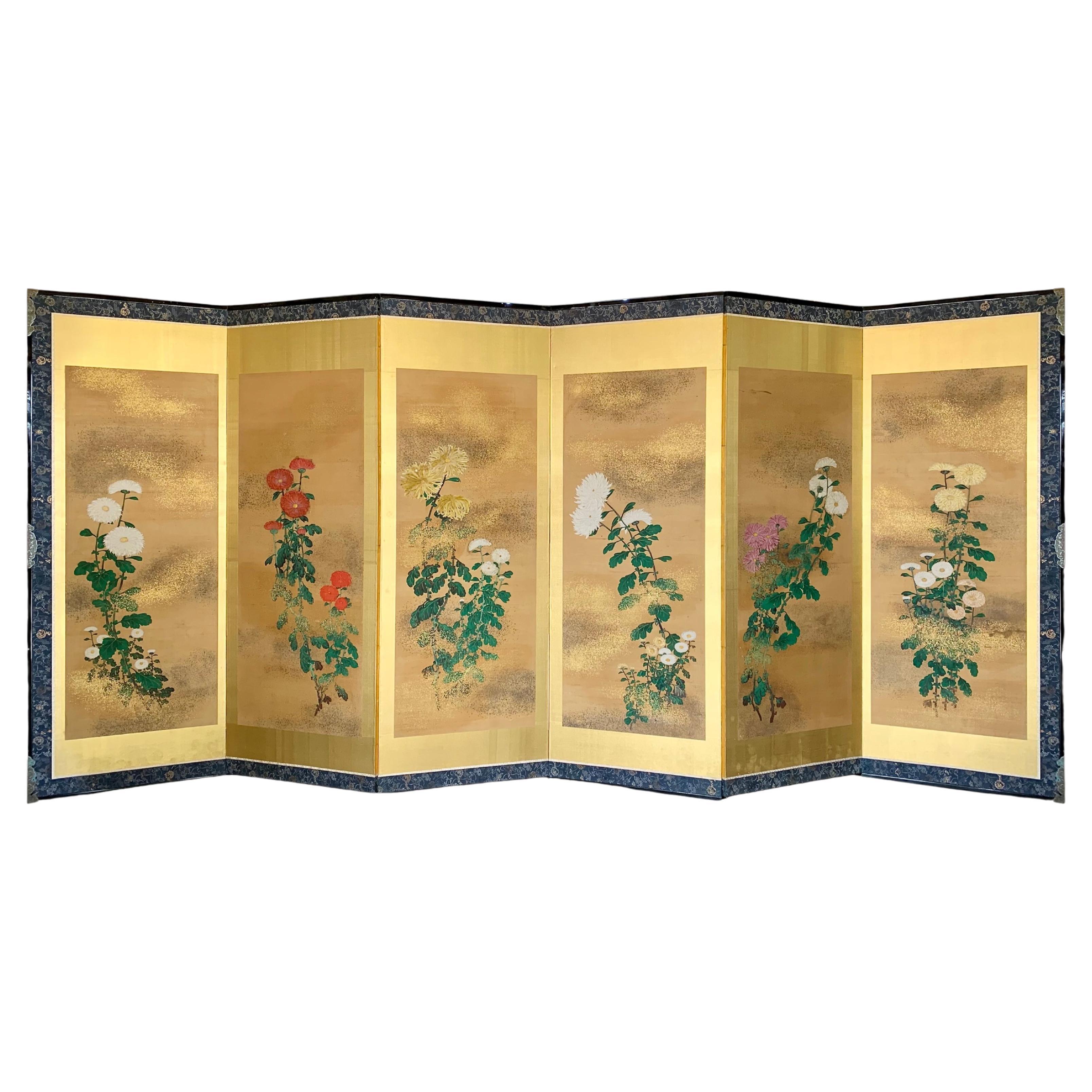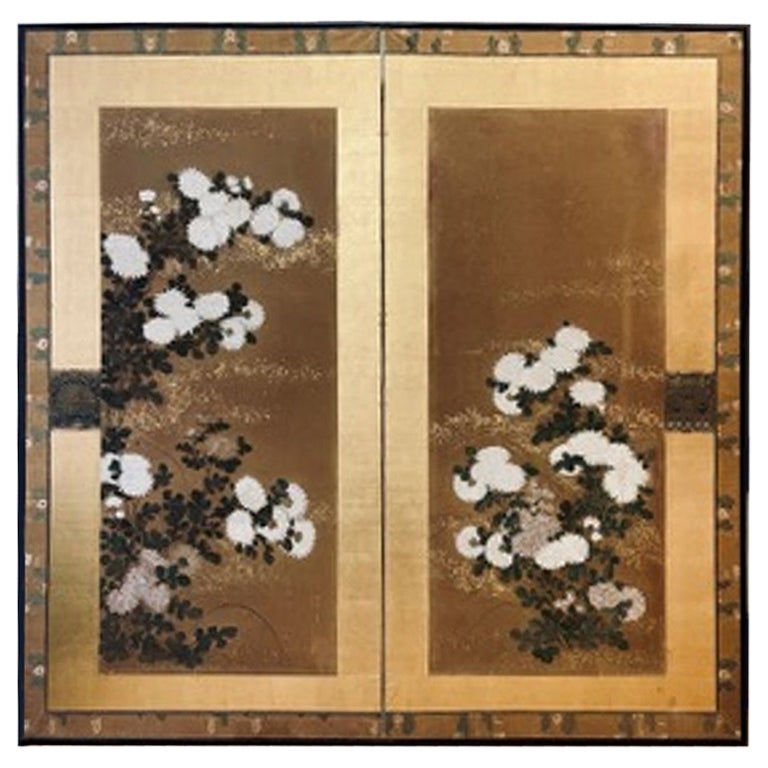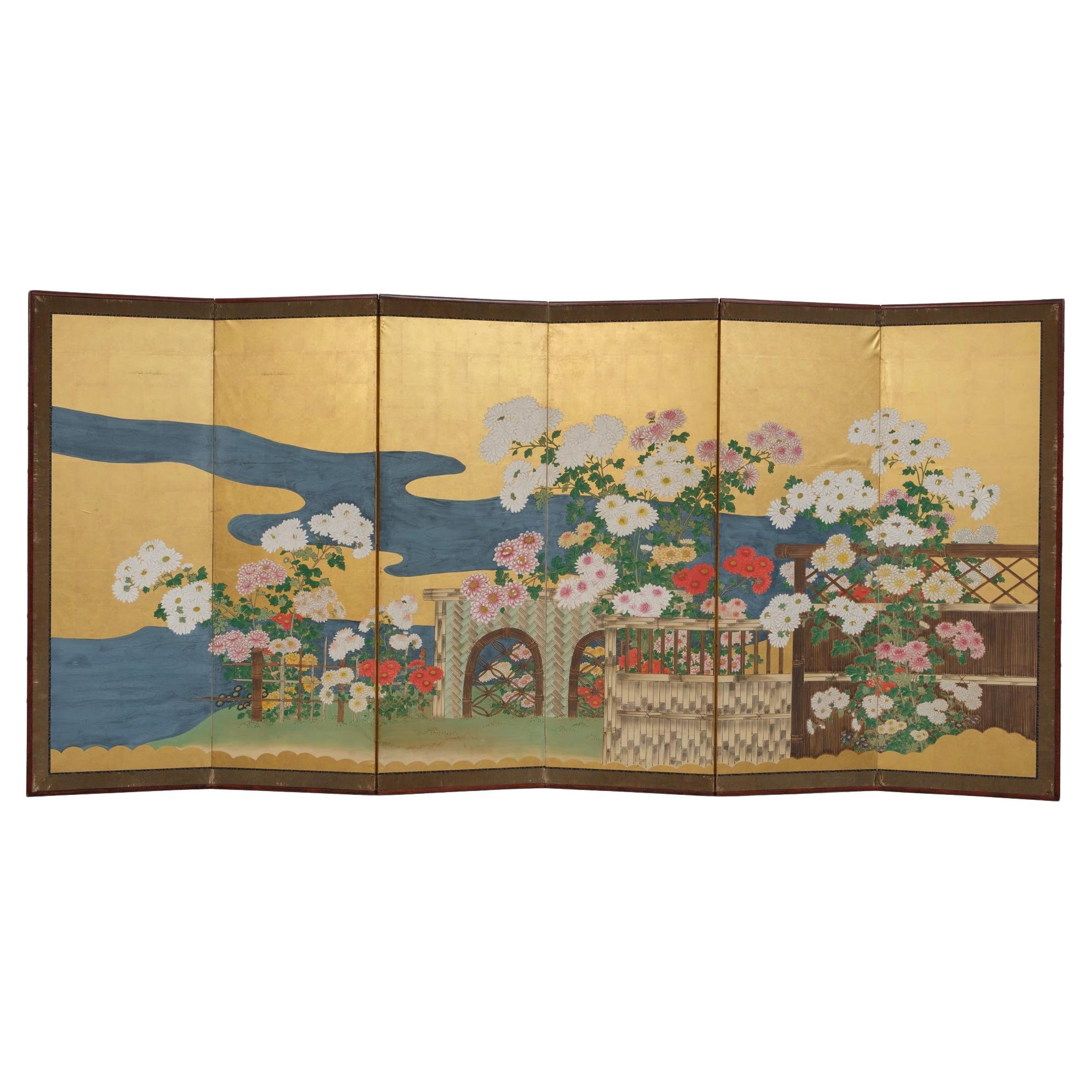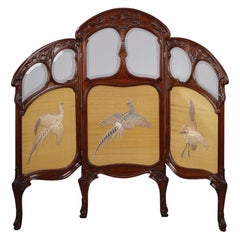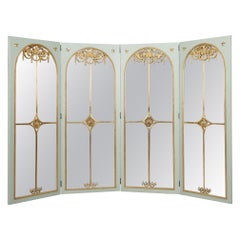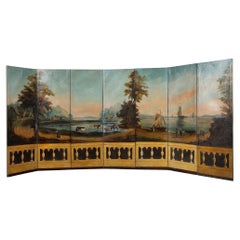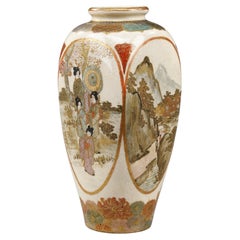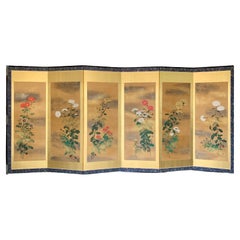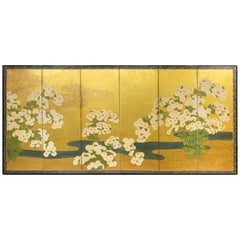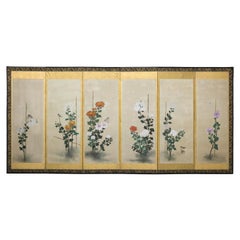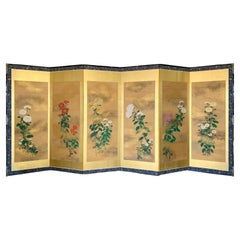Items Similar to Beautiful Chrysanthemum screen with the Honda clan coat of arms. Meiji Japan
Want more images or videos?
Request additional images or videos from the seller
1 of 20
Beautiful Chrysanthemum screen with the Honda clan coat of arms. Meiji Japan
$10,482.23
£7,940.53
€9,000
CA$14,521.71
A$16,287.07
CHF 8,529.28
MX$197,903.73
NOK 108,307.62
SEK 102,683.26
DKK 68,523.90
About the Item
Very large four-leaf folding screen with black lacquered wooden frame, featuring the Honda clan coat-of-arms (Kamon) at the bottom. The panels are adorned with a very delicate wild silk fabric embroidered with a floral design featuring bouquets of Chrysanthemums, the flower symbolizing autumn in Japan. Considered a Buddhist flower and offered in religious ceremonies, it is also the emblem of the imperial family. The leaves are held together by black fabric cords.
- Dimensions:Height: 67.72 in (172 cm)Width: 102.37 in (260 cm)Depth: 1.19 in (3 cm)
- Materials and Techniques:
- Place of Origin:
- Period:
- Date of Manufacture:1890
- Condition:Wear consistent with age and use. In fine condition, with some wear to the fabric and embroidery, and traces of moisture at the top of one of the leaves.
- Seller Location:Paris, FR
- Reference Number:Seller: 34671stDibs: LU2065344971092
About the Seller
4.9
Gold Seller
Premium sellers maintaining a 4.3+ rating and 24-hour response times
Established in 2001
1stDibs seller since 2016
323 sales on 1stDibs
Typical response time: 2 hours
- ShippingRetrieving quote...Shipping from: Montesson, France
- Return Policy
Authenticity Guarantee
In the unlikely event there’s an issue with an item’s authenticity, contact us within 1 year for a full refund. DetailsMoney-Back Guarantee
If your item is not as described, is damaged in transit, or does not arrive, contact us within 7 days for a full refund. Details24-Hour Cancellation
You have a 24-hour grace period in which to reconsider your purchase, with no questions asked.Vetted Professional Sellers
Our world-class sellers must adhere to strict standards for service and quality, maintaining the integrity of our listings.Price-Match Guarantee
If you find that a seller listed the same item for a lower price elsewhere, we’ll match it.Trusted Global Delivery
Our best-in-class carrier network provides specialized shipping options worldwide, including custom delivery.More From This Seller
View AllThree-Leaf Silk and Wood Screen 1900, Stamped Felix Bernard
Located in Paris, FR
Charming Art Nouveau period small three-leaf screen or mantel screen in carved mahogany decorated with embroidery on silk representing birds. The wooden panels are carved with stylized leaves and chestnut fruits. Each leaf is decorated with a bird embroidered on an Indian yellow wild silk. The upper part is openworked with six beveled glass panes set in place. Each panel is carved in the form of arabesques, in a fully Art Nouveau taste. The whole, foldable, rests on four small curved feet ending in a hoof. The central panel is slightly larger than the other two.
This small screen...
Category
Antique Late 19th Century French Art Nouveau Screens and Room Dividers
Materials
Silk, Wood, Glass
Screen room divider with mirrors on each panel in lacquered wood and gilt bronze
Located in Paris, FR
Four-leaf screen in an empire green lacquered wood frame. The main face is richly decorated in gilded bronze with Commedia dell'Arte masks, foliage, garland...
Category
Antique 1880s French Screens and Room Dividers
Materials
Bronze
Folding screen in painted canvas, French work, 1830
Located in Paris, FR
Seven-leaf painted canvas screen depicting a lakeside with a few sailboats on the water, a wooded path animated by characters, a horseman watching over a herd of cows drinking, an op...
Category
Antique 1830s French Screens and Room Dividers
Materials
Canvas
Satsuma porcelain vase from the Meiji period, Japan
Located in Paris, FR
Small porcelain vase in Satsuma earthenware. The 4-sided body is decorated in polychrome and gold enamels with geishas in a garden, a mountain landscape, a bird on a flowering branch...
Category
Antique 1890s Japanese Ceramics
Materials
Porcelain
Japan, Meiji period (1868-1912) : Bronze vase with shaded brown patina
Located in Paris, FR
test
Category
Antique 1890s Japanese Vases
Materials
Bronze
Set of 9 Oban Tate-e Japanese prints from the 19th century
Located in Paris, FR
Long polyptych of 9 oban tate-e prints, illustrating the procession of Emperor Mutsuhito (Meiji) entering, in September 1869, his new capital, the former Edo, renamed Tôkyô "Capital ...
Category
Antique 1880s Japanese Prints
Materials
Paper
You May Also Like
Meiji Chrysanthemum Masterpiece
Located in Fukuoka, JP
Step into a world of timeless beauty with our exceptional six-panel screen from the Edo-Meiji period. In impeccable condition, each panel features stunning paintings of chrysanthemum...
Category
Antique 19th Century Japanese Meiji Paintings and Screens
Materials
Gold
Japanese Six-Panel Screen, Rimpa School Chrysanthemums on Gold
Located in Hudson, NY
An abundant use of gold with beautifully draped chrysanthemums and gold flake clouds. Mineral pigments, go fun, gold leaf on mulberry paper with a silk brocade border.
Category
Antique Early 19th Century Japanese Meiji Paintings and Screens
Materials
Gold Leaf
Japanese Six-Panel Screen with Chrysanthemums and Birds, Taishō Period (1920s)
Located in Yonkers, NY
A refined six-panel Japanese folding screen hand-painted with a graceful arrangement of seasonal chrysanthemums and small birds. Likely dating to the early 20th century during the Ta...
Category
Early 20th Century Japanese Taisho Screens and Room Dividers
Materials
Wood, Paper
Meiji Chrysanthemum Masterpiece
Located in Fukuoka, JP
Step into a world of timeless beauty with our exceptional six-panel screen from the Edo-Meiji period. In impeccable condition, each panel features stunning paintings of chrysanthemum...
Category
Antique 19th Century Japanese Meiji Paintings and Screens
Materials
Gold
Japanese Edo Period Two-Panel Screen with Chrysanthemums
Located in New York, NY
Japanese set of sliding doors that have been mounted as a screen in the early 20th century and the panels from the 19th-century.
ABOUT
This screen is indeed a masterpiece o...
Category
Antique 19th Century Japanese Japonisme Paintings and Screens
Materials
Wood
Large Japanese 6-panel byôbu 屏風 (folding screen) with chrysanthemum garden
Located in Amsterdam, NL
A very colourful and captivating large six-panel byôbu (folding screen) with a refined continuous painting of a luscious flower garden filled with many different types of chrysanthemums (kiku), next to a winding river.
This multi-coloured painting is set on a shiny gold-leaf background, and the chrysanthemum flowers are painted by using shell paste (gofun) in low relief.
Several clutches with a great variety of chrysanthemum flowers are in full bloom and they each show their unique form and colour. Varying from white, red, yellow and pink. The flowers bloom all around and on different kinds of bamboo fences and trellises.
In Japan chrysanthemums are believed to represent happiness, love, longevity and joy.
The panels are surrounded by two silk borders, a thin black one, and a wide brown one. The screen is protected by a black and red negoro’nuri...
Category
Antique Late 19th Century Japanese Paintings and Screens
Materials
Gold Leaf
More Ways To Browse
Antique Emblems
Antique Silk Fabric
Antique Chrysanthemum
Wood Coat Arms
Framed Coat Of Arms
Coat Of Arms Panel
Japanese Silk Screen Flowers
Antique Japanese Black Lacquer Panels
Japanese Buddhist Screen
Japanese Autumn Screen
Imperial Chrysanthemum
Japanese Screen Chrysanthemums
Japanese Four Panel Silk Screen
Four Panel Japanese Folding Screen
Meiji Silk Embroider
Embroidered Coat Of Arms
Japanese Embroidered Screen
Meiji Four Panel Screen
